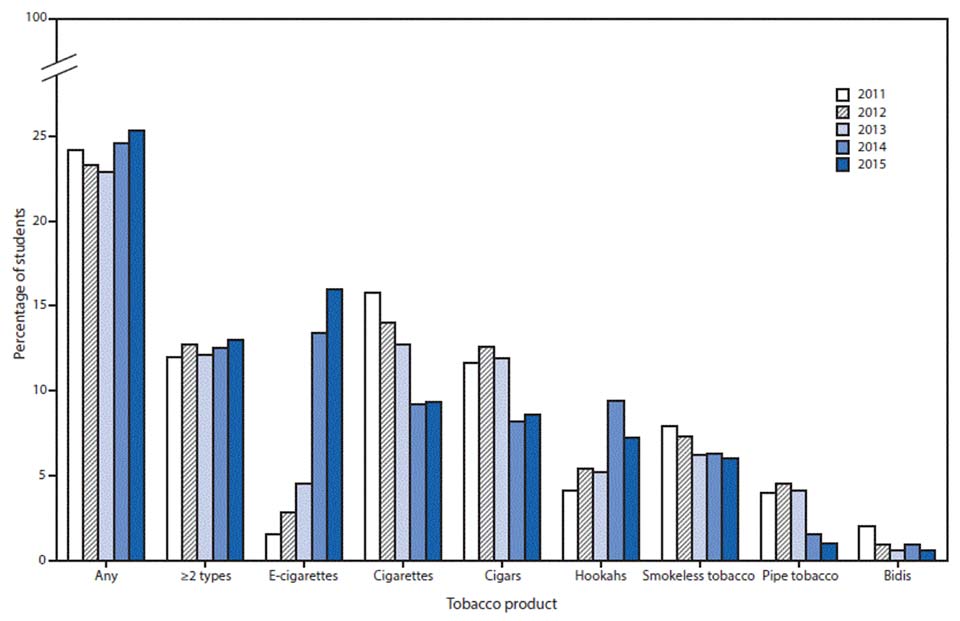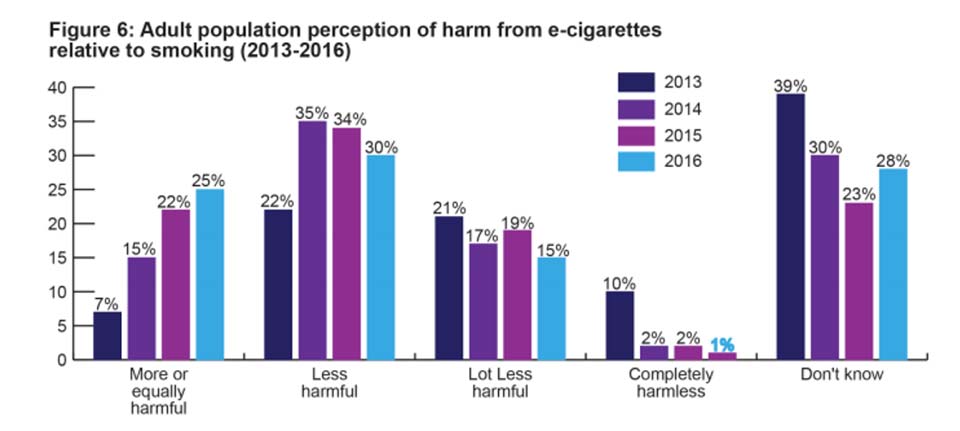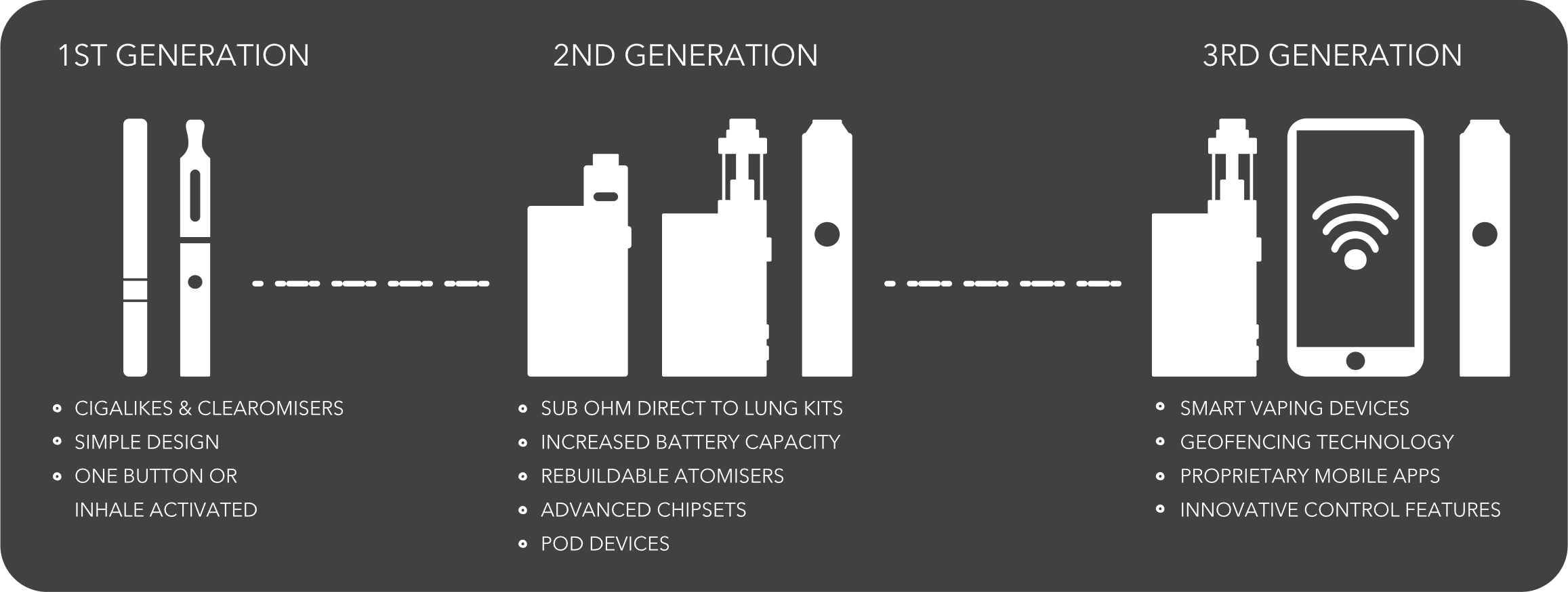Vaping vs. Smoking: The Safety Debate [2020]
The whole reason that e-cigarettes were invented was to provide a less harmful alternative to smoking - one which - unlike traditional NRT’s (Patches, gum etc) - actually feels like smoking, and gives you a genuinely satisfying nicotine hit. Something that is still actually pleasurable, but without the known problems associated with smoking. So naturally, ever since their conception, there has been a great deal of debate over just how safe vape kits really are.
With well over a decade since the first generation of the humble e-cig hit the market, we’ve seen a lot of good and a lot of bad research into vaping/vapour, as well as the dedicated devices and vape liquids used to create it. In the following sections, we’d like to try and sift the fact from fiction and provide you with a brief overview of the evidence for Vaping vs Smoking.
1. THE BASIC PREMISE
Since the 1950’s it has been increasingly well documented that it is the combustion of tobacco and the resultant smoke and tar inhaled, that cause the diseases associated with smoking. These include, lung cancer, COPD, cardiovascular disease, bronchitis, emphysema, and so on. One of the founding fathers of tobacco cessation, Professor Michael Russell, wrote:
"People smoke for nicotine, but they die from the tar".
There are over 5000 chemicals contained in cigarette smoke (source), over 70 of which are known carcinogens. Some occur naturally in the tobacco itself, some come from fertilisers used during cultivation, others get added during the processing stages (including preservatives, flavour enhancers etc), and others are actually created during the combustion process itself.
So the basic premise and the fundamental reason why vaping is less harmful than smoking is quite simple – there is no combustion of tobacco, therefore no smoke, no tar and none of the associated problems. Rather than 5000+ chemicals, the nicotine containing solution or e-liquid, has a relatively simple list of ingredients:
Propylene glycol (PG) and/or vegetable glycerin (VG), nicotine (usually) and flavouring. Sometimes the manufacturer may add a little distilled water to thin out the mixture, but that is basically it.
And that is why even vapings earliest proponents were convinced that it must be safer than smoking – no burning tobacco, and very simple, well known ingredients with what they thought were relatively low risks.
In the words of Iowa Attorney General, Tom Miller - denying that a product with no combustion of tobacco is much less harmful than a product which combusts tobacco, is the ‘equivalent to denying climate change in the environmental context’.
2. ARE THE INGREDIENTS REALLY LOW RISK?
PG and VG (guide to eliquids) are used as the base liquid which carries both the nicotine and the flavouring. Along with the nicotine itself they help to provide the familiar ‘throat hit’ which smokers expect. These 2 ingredients are also what cause the visible vapour that you see, something you don’t get with water vapour and again this helps to mimic the smoking experience.
Both PG and VG are widely used in everyday cosmetics and pharmaceutical products. PG is also used in many foodstuffs, as well as asthma inhalers and nebulisers. Both are considered fairly inert although some people do have a sensitivity to them, and a rare few are unfortunately allergic.
VG is thicker than PG with a slightly sweet taste, but it doesn’t give as much throat hit or carry flavour quite as well. Due to these different properties, varying ratios of both base components are often used in e-liquids (50/50, 60/40, 70/30 etc).
3. BUT… NICOTINE?
Nowadays people are becoming more and more aware that nicotine itself is actually a relatively harmless stimulant (source), very similar in nature to caffeine at the dosage generally used in e-cigarettes and vaping. And contrary to many anti-smoking campaigners, nicotine has no link to cancer.
Yes pure nicotine is a deadly poison, but there is a very old phrase in toxicology “the dose makes the poison” – the often added cliché (source) is that even water is toxic if you drink enough of it!
A report into the toxicity of nicotine at the levels used in e-liquid was commissioned by ECITA (The Electronic Cigarette Industry Trade Association) in 2014. Carried out by Bibra, one of Europe’s leading toxicology firms, it concluded that the majority of e-liquid is less toxic than washing up liquid!!
Professor John Britton, director of the UK Centre on Tobacco and Alcohol Studies, and head of the Royal College of Physicians Tobacco Advisory Group said:
“Nicotine itself is not a particularly hazardous drug, It’s something on a par with the effects you get from caffeine” and that “If all the smokers in Britain stopped smoking cigarettes and started smoking e-cigarettes we would save 5 million deaths in people who are alive today. It’s a massive public health prize”
To coincide with this, UCL (University College London) have released a compelling study into the uptake of smokers switching to vaping. The study, conducted over 13 years, uses data derived from household surveys in England and finds that between 50,000 and 70,000 smokers every year have quit smoking through the use of e-cigarettes. This huge number clearly shows the increase of success rates in cutting out cigarettes through the form of vaping.
4. AND THE REST OF IT!
Well indeed, if e-liquid consisted only of PG, VG and nicotine there would be a shorter story to tell, but there is of course the factor of flavourings. Every reputable manufacturer will only use the highest grade food flavours, and obviously scientists are satisfied these are safe for human consumption when ingested, but when vapourised and inhaled the data simply isn’t there in many cases.
Plus, there are several other factors which mustn’t be forgotten. It is not just the contents of the e-liquid that must be scrutinised, we also have to consider other outside factors. Could any chemicals be leaching from the bottles or the devices themselves? Are any metals released during the heating of the device? What happens to the wicking material? Different temperatures? The list goes on.
This is part of the reason we often hear phrases in the media similar to:
“We have no idea what the long term effects of vaping will be”
And that’s true at this stage, if you are currently a smoker you don’t have 30 years to wait for the research to be finished to find out – we know that smoking definitely kills half of it’s participants. And we do have over a decade of research now, so we can make some very good first impressions and hypotheses about the future at least.
5. SO WHAT DOES SCIENCE TELL US?
This is a very broad area and covers a lot of different aspects, the best way to present this information is to look at this from a critic’s point of view and go through the list of concerns and allegations that are stated about vaping.
E-Cigarettes Contain More Formaldehyde Than A Cigarette
The main culprit for this myth was a report in the New England Journal of Medicine: Hidden Formaldehyde in E-cigarette Aerosols. In this report the authors suggest that exposure to formaldehyde through e-cigarettes was in the region of 5-15 times higher than a combustible tobacco cigarette. Naturally this sent shockwaves through the media and was a very well covered story… however the study was fundamentally flawed and the facts are actually rather different. Unfortunately this hasn’t been so well publicised.
The major flaw with this study was the fact that the e-cigarette was tested under very unrealistic conditions, which would never be replicated by a vaper. The device was operated at such a high temperature (far above the recommended use) that the e-liquid was unable to wick fast enough, causing what are known as ‘dry puffs’ - where the atomizer heats up but the cotton is dry and causes it to burn rather than vapourising the liquid. It is this process that produces thermal degradation products - including formaldehyde.
However, no vaper would actually be able to use a device in these conditions. The vapour prodcued would be truly disgusting and totally un-vapable - something which anyone who has ever experienced a dry puff will tell you. One hit and you are coughing your lungs up - you don’t go back for a second!!
This video shows Sarah Jake of the New Nicotine Alliance trying to vape under similar conditions to those used in the NEMJ report.
Dr Konstantinos Farsalinos and Clive Bates wrote an excellent complaint to the authors of the study asking for it to be retracted (it wasn’t unfortunately) which goes into more detail.
What this study really showed us was that if used in the wrong conditions that the devices were capable of producing large amounts of formaldehyde, but more interestingly - that the scientist’s conducting these experiments simply did not understand the devices they were testing and the proper use of them. Something you would imagine to be fundamental when conducting a scientific study.
Vaping Is As Bad For Your Heart As Cigarettes
A myth which has been perpetuated by most of the tabloids. The Sun actually ran this as a front page headline, while The Daily Mail, The Mirror, The Telegraph and The Times all ran major pieces too.
The claims were made at the European Society of Cardiology congress in Italy, by Professor Charalambos Vlachopoulos, of the University of Athens Medical School, and despite the alarming headlines it turned out to be a bit of a storm in a teacup. It was claimed that vaping increases aortic stiffness and blood pressure, yet this is a known side effect of nicotine and very similar results occur from drinking coffee or taking exercise.
Professor Peter Hajek, director of the Tobacco Dependence Research Unit at the Wolfson Institute of Preventive Medicine at Queen Mary University London, explains it very well:
“The study is reporting on a well-known short-term effect of nicotine – stiffening of arteries – that accompanies all types of stimulation. The same effect is generated by watching a thriller or a football match or sitting an exam. Drinking a cup of coffee actually produces a larger response of a much longer duration. The key heart health risks of smoking are not caused by nicotine but by other chemicals in tobacco smoke that are not present in e-cigarette vapour.”
Passive Vaping
Nowadays we are all aware of the dangers caused by passive smoking, so it was natural that people would have concerns around vaping. Fortunately several studies have been conducted which all point to the conclusion that passive exposure to vapour poses little to no danger at all.
A paper released by C. Romagma MD et al, entitled Characterization of chemicals released to the environment by electronic cigarettes use (ClearStream-AIR project): is passive vaping a reality? Which looked at a comparison of secondhand tobacco smoke and secondhand vapour. It’s conclusions were:
“The above experiment, within the limits of the observed parameters, has underlined that e-smoking does not produce detectable amounts of toxic and carcinogenic substances in the air of an enclosed space. Further studies are needed to better understand all the involved aspects. However this preliminary assessment indicates that passive vaping impact, when compared to the traditional cigarette smoking, is so low that it is just detectable, and it does not have the toxic and carcinogenic characteristics of cigarette smoking. The absence of combustion and the lack of sidestream smoking, with its known toxic effects] are probably the main reasons for the differences observed in air pollution characteristics”
In October 2012, the medical journal Inhalation Toxicology published Comparison of the effects of e-cigarette vapor and cigarette smoke on indoor air quality which drew the conclusion that:
“For all byproducts measured, electronic cigarettes produce very small exposures relative to tobacco cigarettes. The study indicates no apparent risk to human health from e-cigarette emissions based on the compounds analyzed.”
In June 2012, T Schripp et al published the report Does e-cigarette consumption cause passive vaping?. This study looked at 20 common volatile organic compounds (VOC’s) found in cigarette smoke and compared the levels to that of e-cig vapour. Despite only using a 6ft cubed chamber (real life scenario would have a much larger space) the results were very clear.
Exhaled tobacco smoke scored high for all 20 VOC’s, yet in exhaled vapour 15 were completely absent, and the remaining 5 were in tiny amounts, at levels which do not pose health risks. Formaldehyde, being a chemical of particular concern, was noted for being present at similar levels to the air prior to the experiment.
One of the most widely acclaimed reviews of scientific literature on the matter was published in August 2013 - Peering through the mist: systematic review of what the chemistry of contaminants in electronic cigarettes tells us about health risks. The conclusion pointed out that although there is a need to continue to monitor the effects of long term use on the vaper themself, there was no risk to bystanders:
“Current state of knowledge about chemistry of liquids and aerosols associated with electronic cigarettes indicates that there is no evidence that vaping produces inhalable exposures to contaminants of the aerosol that would warrant health concerns by the standards that are used to ensure safety of workplaces. However, the aerosol generated during vaping as a whole (contaminants plus declared ingredients) creates personal exposures that would justify surveillance of health among exposed persons in conjunction with investigation of means to keep any adverse health effects as low as reasonably achievable. Exposures of bystanders are likely to be orders of magnitude less, and thus pose no apparent concern.”
Vaping Is A Gateway To Smoking For Children
This particular fallacy has unfortunately stemmed from the anti-smoking campaigners who are unable to make a distinction between vaping and smoking - under the impression that they are all tobacco products (which we all know they aren’t). And now even the US Surgeon General is spreading the misinformation and scaremongering too
The major problem here is that the statistics actually point to the complete opposite conclusion. Just like for adults, e-cigarettes seem to be acting as a gateway AWAY from smoking…
He rightly informs the reader that youth use of e-cigarettes has risen. The website tells us:
“Between 2011 and 2015, past-month e-cigarette use grew dramatically among middle school and high school students. E-cigarettes are now the most commonly used form of tobacco by youth in the United States. Dual use, or use of e-cigarettes and conventional cigarettes by the same person, is common among youth and young adults (ages 18-25).”
But what he doesn’t tell the reader is that coincides with a very significant drop in the rate of youth smoking in the US

Source: CDC, Tobacco Use Among Middle and High School Students - US, 2011-2015
Vaping Is As Bad For You Or Worse Than Cigarettes
There is a very alarming trend amongst adults in the UK, where perceptions that e-cigarettes are worse or as bad as smoking have actually increased by 18% over the last 3 years - despite the fact that more and more reports have been published which positively prove the opposite.

This graph was taken from the 2016 ASH Fact Sheet: Use of Electronic Cigarettes (vapourisers) among adults in Britain.
But how has this happened? It’s a perfect example of the power of the press. Simply put, the misinformation, poor reporting and the new clickbait culture have propagated false perception among the population. Let’s face it bad news sells papers, good news doesn’t - so even when the negative stories are debunked, they don’t get any column space and so the views of the general public are moulded on incorrect information - which in this particularly case is not just poor practice from the news outlets, but actually could prove fatal for many smokers.
So how much safe is vaping compared to smoking? Public Health England (PHE), are a government body whose purpose is to “to protect and improve the nation's health and wellbeing, and reduce health inequalities.” They state on the website that one of their responsibilities is:“researching, collecting and analysing data to improve our understanding of health and come up with answers to public health problems” and in the case of vaping that is exactly what they have done….
In August 2015 PHE published a ground-breaking, and internationally renowned report entitled E-Cigarettes: An Evidence Update. The report was commissioned by PHE and conducted by members of the National Centre for Tobacco and Alcohol Studies (lead by Ann McNeil and Peter Hajek). The report reviewed all of the evidence available at the time of writing. The aim being to:
“to ensure that practitioners, policy makers and, most importantly of all, the public have the best evidence available.”
Here is a summary of their conclusions:
-
- Smokers who have tried other methods of quitting without success could be encouraged to try e-cigarettes (EC) to stop smoking and stop smoking services should support smokers using EC to quit by offering them behavioural support.
- Encouraging smokers who cannot or do not want to stop smoking to switch to EC could help reduce smoking related disease, death and health inequalities.
- There is no evidence that EC are undermining the long-term decline in cigarette smoking among adults and youth, and may in fact be contributing to it. Despite some experimentation with EC among never smokers, EC are attracting very few people who have never smoked into regular EC use.
- Recent studies support the Cochrane Review findings that EC can help people to quit smoking and reduce their cigarette consumption. There is also evidence that EC can encourage quitting or cigarette consumption reduction even among those not intending to quit or rejecting other support. More research is needed in this area.
- When used as intended, EC pose no risk of nicotine poisoning to users, but eliquids should be in ‘childproof' packaging. The accuracy of nicotine content labelling currently raises no major concerns.
- There has been an overall shift towards the inaccurate perception of EC being as harmful as cigarettes over the last year in contrast to the current expert estimate that using EC is around 95% safer than smoking.
- Whilst protecting non-smoking children and ensuring the products on the market are as safe and effective as possible are clearly important goals, new regulations currently planned should also maximise the public health opportunities of EC.
- Continued vigilance and research in this area are needed
The most important take home message here was that according to all the science available, vaping is 95% safer than smoking! It is not ‘safe’ (but inhaling anything other than clean air is not going to be 100% safe) but as an alternative to smoking it is an enormous public health win.
Product Safety and The Evolution of Vaping
Aside from the actual health impact, stories about poisoned pets and exploding batteries have naturally caused concern that the e-liquid containers and the vaping devices themselves are not safe. But what is the truth?
Contrary to popular belief, the devices and the refill liquids have been subject to the consumer goods regulations from day zero, however the enforcement of these regulations was a little lackadaisical and they weren’t really specific enough to cover all aspects of the products.
However in 2014 the Tobacco Products Directive (TPD) was updated to include new regulations for the manufacture and retail of nicotine containing liquid and vaping products. These regulations became law in 2016 and is known as the Tobacco and Related Products Regulations or TRPR.
Subject to considerably controversy the legislation aims to ensure that the products on the market are as safe for the end user as possible. They include regulations on the ingredients used in e-liquids (including a list of banned ingredients), requirements for emissions results, toxilogical data and strict rules on packaging (child safety caps on e-liquids, correct warnings etc).
Some of the regulations are considered by many businesses and consumers as far too over-reaching. The main ones being: a limit on e-liquid bottle size to 10ml (bleach is far more toxic and is available in litres!); tank size limited to 2ml (which means many people will have to fill their tank more often, and have more chance of spilling the liquid!); nicotine strength capped at 20mg/ml (significant percentage of vapers have started on 24mg.ml - particularly if they were a heavy smoker); and too many advertising restrictions.
However, despite these complaints the fact remains that these regulations will ensure that all vaping products put on to the UK market meet strict safety requirements and will give the consumer confidence. It is highly likely that over time future revisions to the legislation will address the more controversial restrictions and make the regulation as proportionate and sensible as possible.
Saying this, it’s interesting to see the safety of e-cigarettes has coincided with the evolution of vaping. This is not to say the first vape kits back in 2003 weren’t suitable for use, but since then manufacturers have pioneered new techniques to further the vape experience whilst providing innovative safety features to protect you and your device.

The evolution of the e-cigarette can be categorised into three generations; the first being the simple design of cigalikes and clearomisers which hit the market back in 2003. Unfortunately, whilst Hon Lik’s humble invention was heralded as a shift in attitudes towards smoking and cessation, these basic devices didn’t hit the market as well as previously predicted.
The second generation swiftly followed around the 2008 mark, with the birth of pod devices, sub ohm vaping and rebuildable atomisers, equipped with advanced chipsets and increased battery capacities. This catapulted the vape industry into a fully fledged, burgeoning market which developed a culture of its own, with the rapid growth of e-liquid brands providing enthusiasts with some much needed versatility and personality to vaping.
The third and present generation is commonly referred to as ‘the smart vaping generation’, noted for its use of proprietary mobile phone apps and cutting edge control features. This allows vape devices to incorporate the latest state of the art technology to make vape devices more than just vape devices. This includes geo fencing technology to stop vapers firing up in school zones as well as intuitive bluetooth speaker vape mods so you can play music whilst vaping.
6. CONCERNS FOR THE FUTURE
As always there are concerns over the future of vaping, particularly in terms of tobacco companies wanting to reap their losses by trying to tarnish vaping at every possible occasion.
We’ve mentioned the need for vigilance and investigation a couple of times, but as of yet we do not have any data on the long term use of e-cigarettes and vaping. Without this, it is impossible to know the full story and it is something that can only reveal itself with time. However, there is resounding studies and evidence from admired public health organisations suggesting vaping is 95% less harmful than smoking, whilst also being a highly successful way to quit smoking entirely.
The Truth Behind The Vaping Illness
Information is now coming to light regarding the recent ‘vape-related’ deaths in America. Whereas previously it was thought that vaping as a whole was to blame, it is now becoming clear that the health issues being experienced are in fact due to black market products that contain illicit and dangerous substances, you can listen to the Freakonomics podcast below:
We hope this has settled any concerns over the legitimacy and harm-reduction of vaping. If you have any other queries surrounding vaping vs smoking or vaping in general, please do not hesitate to contact us.
How To Guides & Useful Information


